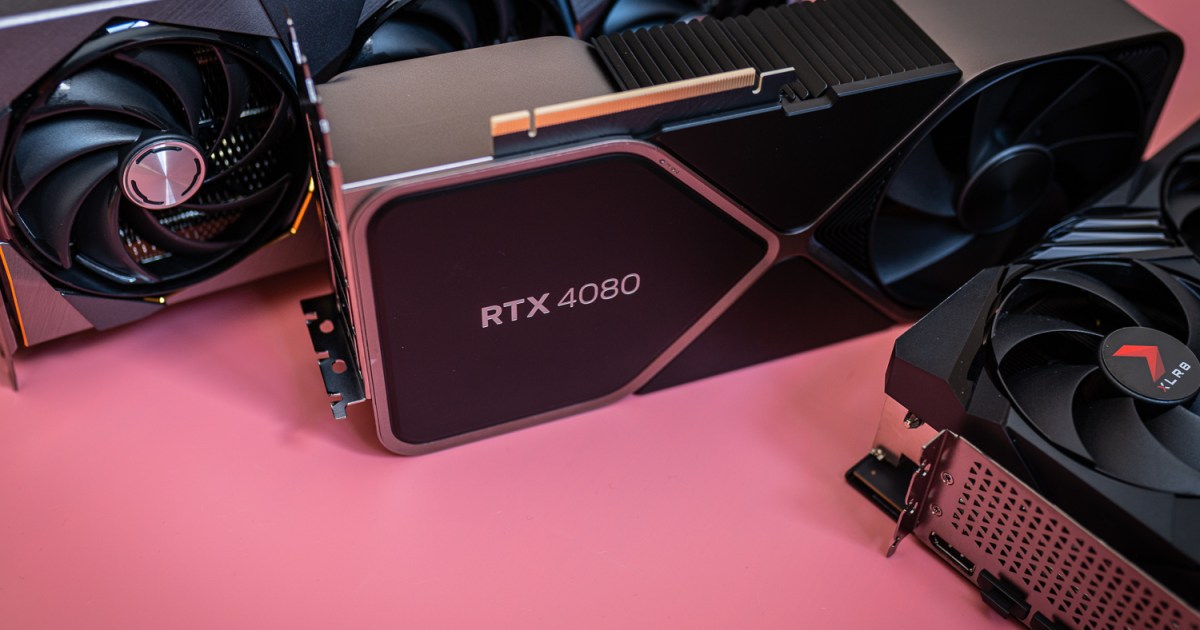Nvidia’s RTX 4080 didn’t have a warm reception when it first launched, but a series of slow price drops have made it a more attractive option among the best graphics cards. However, stock is quickly drying up, with most retailers offering only a few models at list price. Is now finally the time to pull the trigger?
Stock is likely disappearing due to Nvidia’s rumored Super refresh. A mountain of evidence has all but proven that Nvidia is gearing up to launch new graphics cards, including the RTX 4080 Super. Without the official details, it’s tough to know if you should wait for the new GPU, but we’re here to break down everything we know about the card right now.
Pricing and availability
The RTX 4080 has been around for months. Nvidia launched the card over a year ago for a list price of $1,200. It didn’t hold at that price for long, with models available for most of last year between $1,000 and $1,150, but prices have slowly started to creep back up. At the time of writing, the cheapest model I could find was this
.
Why the sudden price increase? VideoCardz reports that Nvidia has stopped production of the RTX 4080 and RTX 4070 Ti, presumably to clear the way for new Super cards. If that’s the case, retailers are likely trying to get the most out of their small remaining inventory. If and when the RTX 4080 Super is released, I suspect the last few RTX 4080 models will go for a much cheaper price.
As for the RTX 4080 Super, we don’t know the price yet. Early reports about the GPU suggested Nvidia would release it at the same list price as the base model: $1,200. That seems likely, given that the base RTX 4080 was widely considered too expensive at its list price. It’s hard to believe the Super model would be popular at an even higher price.
The bigger question is if the base RTX 4080 will still be in stock when the Super card releases. We know there are precious few models available, and I suspect the remaining inventory will dwindle in the coming weeks. That could be a good opportunity to get the base RTX 4080 at a good price, but you’ll need to be ready to pick one up if you spot a deal.
Specs
Outside of Nvidia confirming its keynote at CES 2024, the company hasn’t revealed anything about the RTX 4080 Super. From a specs perspective, we’re dealing entirely with rumors right now, so keep that in mind as we go over the comparison to the RTX 4080.
From rumored specs, it appears the RTX 4080 Super is somewhat of a lateral move for Nvidia. The card is rumored to come with 10,240 CUDA cores, which is just a 5% increase over the base RTX 4080. It’s also rumored to come with the same 16GB of GDDR6X memory on a 256-bit bus and with the same power draw of 320W.
Elsewhere, rumor has it that the maximum boost clock speed is getting a 2% bump to 2,550MHz, and the memory speed is going from 22.4 Gbps to 23 Gbps. According to reporting from VideoCardz, out of all of the Super cards, the RTX 4080 Super will receive the smallest bump in specs.
That probably explains the earlier reports about Nvidia stopping production of the base RTX 4080. Based on specs alone, it appears the Super model serves as a way for Nvidia to extend the life of the RTX 4080 without dropping its price any further. Nvidia seems to be pushing the RTX 4070 Ti Super and RTX 4070 Super much harder, suggesting these cards will deliver a larger performance increase over their base models.
Performance
Given the rumored specs of the RTX 4080 Super, it’s hard to imagine it will be much faster than the base RTX 4080. The bump in core count and clock speed will help it hold an edge, but I suspect that edge will be in the lower single digits in most games.
Let’s get some context, though. The RTX 4080 comes with 36% more CUDA cores than the next step down in Nvidia’s current lineup, the RTX 4070 Ti. It also comes with a bump to memory, 100W more power, and a slight bump to clock speed. After adding all of those factors up, the base RTX 4080 ends up about 26% faster than the RTX 4070 Ti at 4K on average.
As you can see, a core count increase doesn’t scale linearly with performance, clock speed, or power demands. In most cases, the performance jump is less than the sum of its parts in real-world performance.
How does that relate to the RTX 4080 Super? Well, we can see from the rumored specs that there probably won’t be a huge jump over the RTX 4080. Given that, the performance improvements will likely be small, and in some games, there may not be performance improvements at all.
Should you wait?
With prices of RTX 4080 models holding at around $1,200, I would recommend holding off on picking up a card until we see what the Super refresh has to hold. Assuming it will launch at the same list price, it’s better to get a small performance bump, no matter how small that performance bump may be.
However, that doesn’t mean the RTX 4080 Super is the better card. As mentioned, prices on remaining RTX 4080 models will likely drop in response to the Super release, and there will be a narrow window to pick up those remaining cards. That’s the best play for most people. It doesn’t appear like the RTX 4080 Super will provide a big advantage over the base RTX 4080, so if you can score a deal on Nvidia’s older card, that’s the way to go.
Editors’ Recommendations

